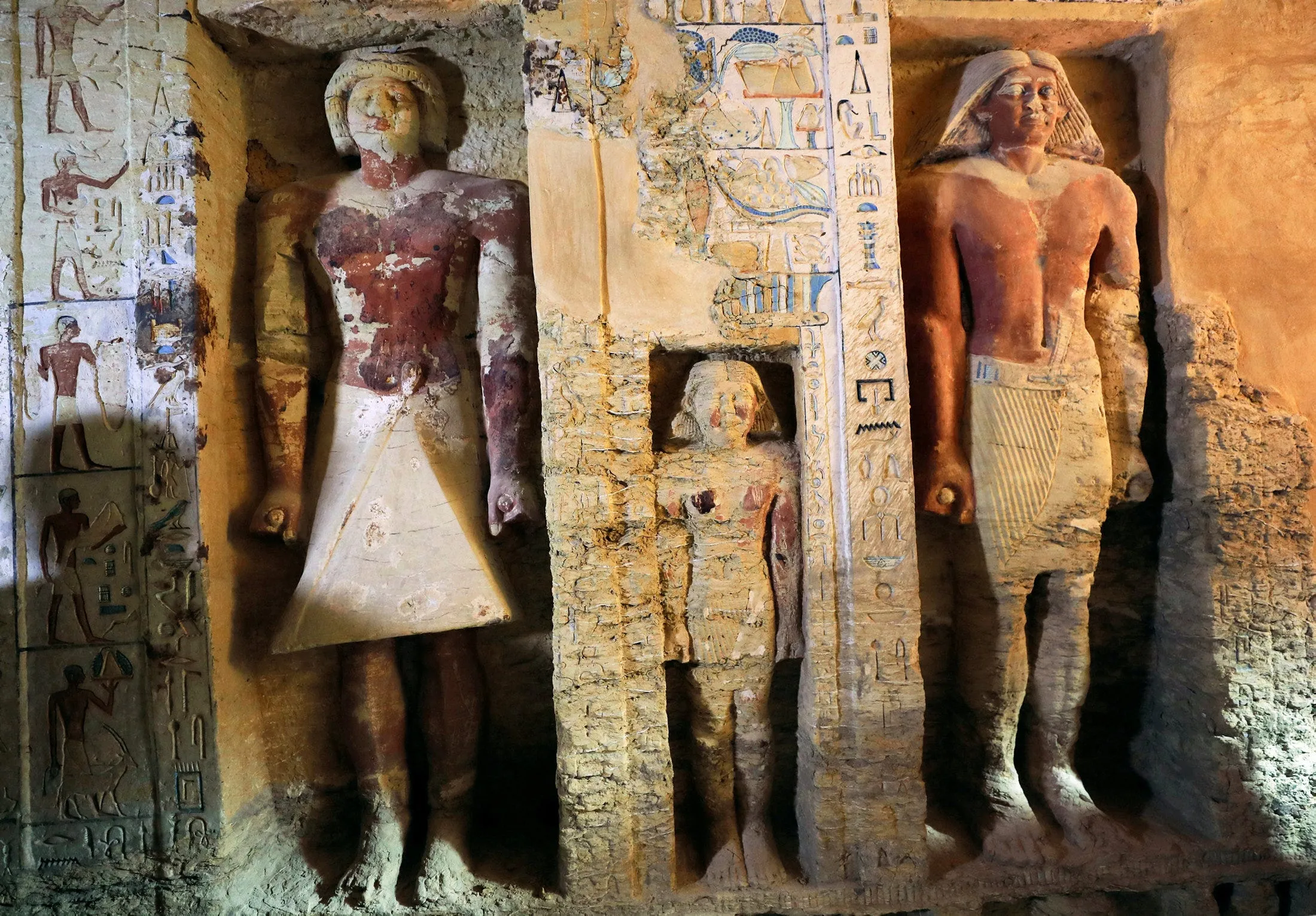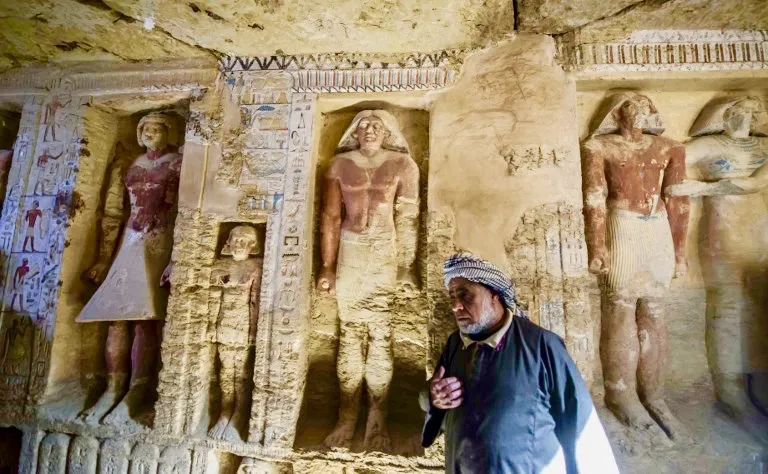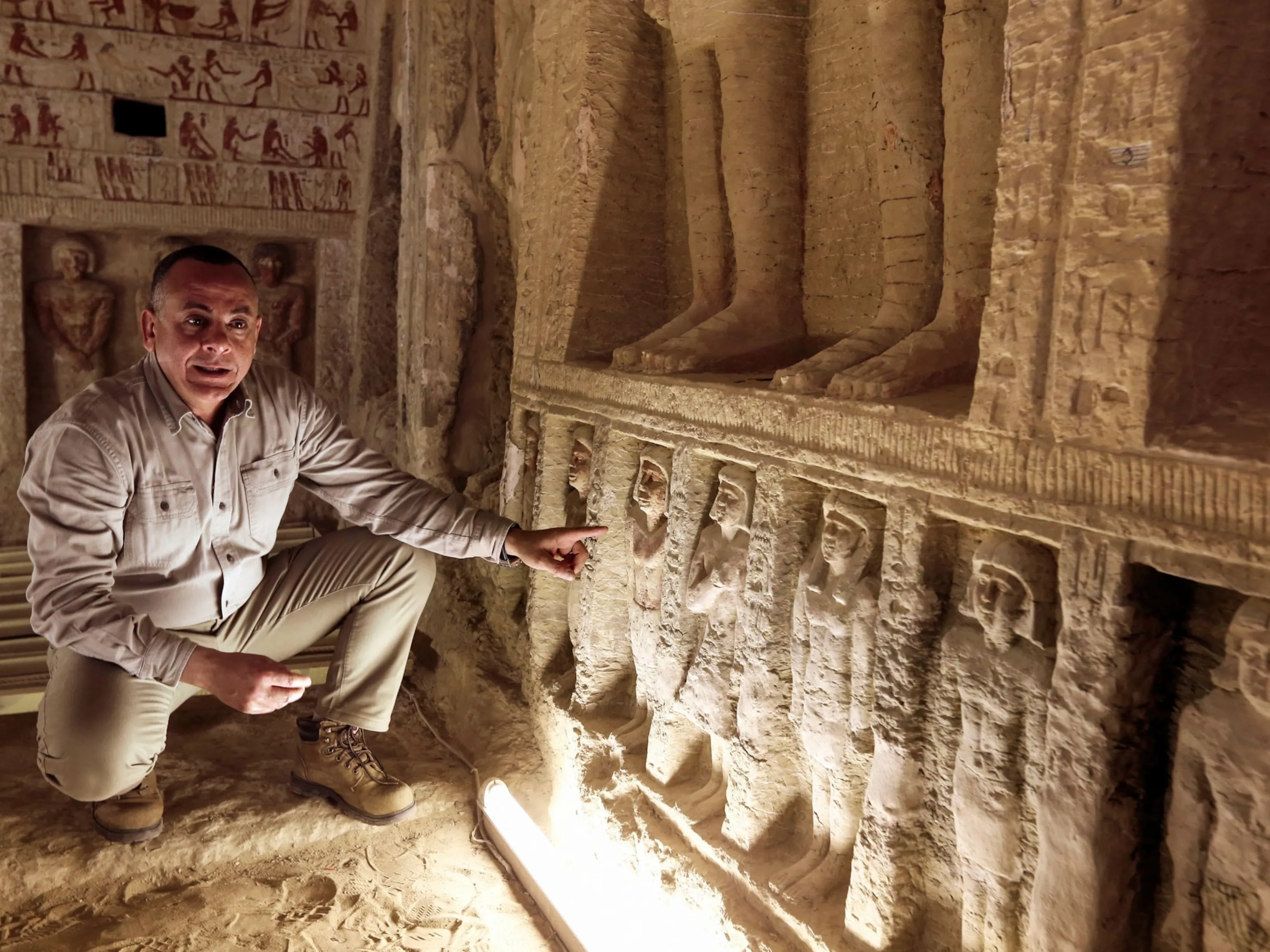Archaeologists in Egypt have announced the discovery of a tomb untouched for 4,400 years, belonging to a high-ranking priest whose burial chamber remains remarkably intact. The find, located at the Saqqara necropolis south of Cairo, has been hailed by officials as “one of a kind in the last decades” due to its pristine condition, vibrant colors, and richly decorated walls.
A Rare Window Into the Fifth Dynasty

The tomb was uncovered buried in a ridge close to the pyramid of Djoser, Egypt’s oldest stone pyramid. Inside, archaeologists found hieroglyphic inscriptions and painted reliefs so vivid they appeared as though created only recently, despite surviving for over four millennia.
The priest, named Wahtye, served during the Fifth Dynasty under King Neferirkare (circa 2500–2300 BC). Hieroglyphs carved above the entrance record his multiple prestigious titles, reflecting his prominence within the royal court. Wahtye is depicted repeatedly in the tomb’s reliefs alongside his mother Merit Meen, his wife Weret Ptah, and his children, showing not only his devotion to family but also the social importance of kinship in ancient Egyptian life.
Colors That Defied Time
According to Mostafa Waziri, secretary-general of the Supreme Council of Antiquities, the survival of the tomb’s colors is “astonishing.” Scenes show everyday activities such as hunting, sailing, pottery making, and offering rituals. These depictions provide archaeologists with a vivid narrative of life during Egypt’s Old Kingdom, illustrating both domestic and religious practices.
The chamber itself measures 33 feet long, 9 feet wide, and nearly 10 feet high, making it a compact yet elaborate shrine to Wahtye’s memory. Sculptures, reliefs, and inscriptions cover its walls, blending artistry and devotion in a way that underscores the sophistication of ancient craftsmanship.
Five Shafts Offering New Mysteries

Inside the tomb, archaeologists discovered five vertical shafts. One had already been opened and found empty, but the other four remained sealed. Waziri expressed optimism that at least one shaft may lead to Wahtye’s sarcophagus, along with other funerary treasures. “This shaft should lead to a coffin or a sarcophagus of the owner of the tomb,” he explained, highlighting the potential for further groundbreaking discoveries in the coming months.
Saqqara: Eternal City of the Dead
Saqqara, part of the ancient capital of Memphis, served as a vast necropolis for more than 2,000 years. It is home to pyramids, mastabas, and tombs belonging to pharaohs, nobles, and priests, each contributing to Egypt’s legacy as one of history’s most enduring civilizations. The site’s importance lies not only in its monuments but also in the insight it provides into evolving burial customs, art, and architecture across different dynasties.
This discovery reinforces Saqqara’s reputation as a site of continual archaeological surprises. In recent years, archaeologists have uncovered caches of mummies, colorful coffins, and even animal burials, ranging from sacred cats to crocodiles. These finds illustrate the Egyptians’ complex spiritual world and their efforts to prepare both humans and animals for the afterlife.
A Golden Age of Discovery

Egypt’s Ministry of Antiquities has announced multiple significant discoveries in quick succession, pointing to what many experts call a new “golden age of archaeology” for the country. In November 2018 alone, researchers unearthed eight limestone sarcophagi containing mummies from the Late Period (664–332 BC). Just days earlier, the intact coffin of a woman dating back more than 3,000 years was revealed in Luxor, still decorated with striking ochre and blue paint.
These discoveries are not only of historical significance but also serve as vital cultural treasures, drawing worldwide attention to Egypt’s rich heritage. They contribute to tourism, inspire further academic study, and rekindle global fascination with one of humanity’s most extraordinary civilizations.
Preserving the Legacy
Experts stress the importance of conserving these fragile sites, as Egypt’s desert climate can be both a preserver and a threat. While dry sands have shielded Wahtye’s tomb for millennia, human activity and environmental changes mean that careful excavation and protection are essential. Plans are already underway to prepare select artifacts and reliefs from the site for display at the forthcoming Grand Egyptian Museum in Giza, scheduled to become one of the world’s largest archaeological museums.
A Glimpse Into the Soul of Ancient Egypt
The discovery of Wahtye’s tomb is more than just a remarkable archaeological achievement—it is a powerful reminder of the humanity that lived, loved, and worshipped thousands of years ago. The priest’s devotion to his mother, the vivid scenes of work and play, and the anticipation of hidden treasures in the sealed shafts all contribute to a story that continues to unfold.
As further excavations continue, the tomb promises to shed even more light on Egypt’s Old Kingdom, a period often overshadowed by the later grandeur of the New Kingdom pharaohs. In Wahtye’s eternal resting place, history speaks clearly: of devotion, artistry, and the unbroken thread that connects the living to the ancient past.
